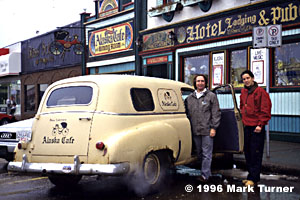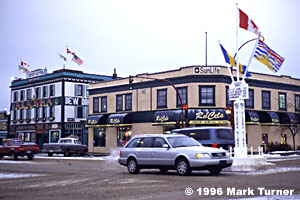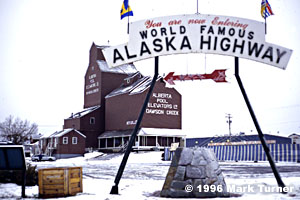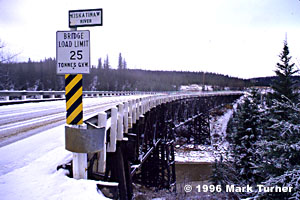Day 3: October 21
Dawson Creek to Fort Nelson, BC
by Mark Turner

The Alaska Hotel in Dawson Creek was a charming old-fashioned place to stay. The tiny room was neat and clean, but clearly showing its 1930’s vintage, as were the bathrooms at the end of the hall. We awoke to the sound of the garbage truck in the alley below us and arose to find rain dripping from the eaves onto the slushy snow below. We walked around the corner to the bakery for sweets and a cup of coffee for breakfast and loaded up. While Emanuel showed Rich the hotel’s courtesy van, a well-worn 1953 Pontiac Panel Truck, I started looking for a set of tire chains.

Chains to fit the Audi’s P195-65/R15 tires proved unbelievably difficult to find in a town which gets tons of snow each winter. The tire store I tried first sent me to Northern Metallic, which sent me to Peavey which sent me to Kal Tire which sent me on to Ft. St. John where I tried another Northern Metalic and finally found cable link chains at Canadian Tire. Northern Metalic in Ft. St. John services the oil and gas industry in the area. The store had monster steel cable, overalls, chain in all sizes, big tools, and in the back corner a man was making up a set of gigantic tire chains for a dual-wheel truck from a box of parts. His pliers had handles a meter long. I could have waited a day for a set of custom chains, but I chose to continue my search.

The northward trek up the Alaska Highway didn’t get underway until about 11:30. Road conditions were wet and slushy, but the Audi never wavered. An opportunity presented itself to take a brief side trip to cross and photograph the historic curved wooden bridge over the Kiskatinaw River. The highway has been rerouted over a new high bridge which is another beautiful example of the civil engineer’s art with a single pier in the center of the river supporting a giant ‘V’ rising seemingly hundreds of feet to the underside of the roadway.
Driving north the temperature dropped from 35 to 19 F and the slush gave way to packed snow on the road surface. Traffic was moderately heavy, with another vehicle coming the other way every few minutes. There were numerous trucks bearing wide loads of construction equipment, many pickups, and a handful of southbound RVs. The area is dotted with gas wells hidden in the thick spruce forest, reached by periodic snow-covered dirt roads branching off the main highway. For the first 150 km the forest was being actively logged, and many loaded logging trucks were encountered on the road.
The clearcuts have been replanted, and marked with signs bearing the year of planting and singing the virtues of renewable forests. To my eye, the regrowth rate was about half that of northwest Washington forests. I couldn’t identify the species of trees, but one of the books I read suggested that they were white spruce. In any case, the tallest trees were small by western Washington standards, and the branches were very short and stiff to withstand the heavy winter snows.

Driving further north, less logging was encountered. There were very few businesses or homes along the next 300 miles. For the most part the pattern of gently rolling hills continued. The road was wide and smooth, except for a bit of occasional roughness from the packed snow. Some places I could see the wide swath of the highway right-of-way for miles ahead. The cleared stripe through the forest was nearly four times the width of the roadway itself.
The towns of Wonowon, Pink Mountain, Sikanni Chief, Buckinghorse River, and Prophet River were really nothing more than a couple of roadside businesses — a place to get something to eat, fill your tank, and maybe spend the night. I sped past them all under leaden skies.
Today’s drive was the first time any significant wildlife was encountered. At the bottom of Pink Mountain a sign warned of moose on the road, but they remained elusive. I did find several groups of caribou along the road over the next 100 km, sometimes a single animal, sometimes a pair, and once a group of about a dozen. Within a kilometer of passing the large group I also saw a gray fox in the snow along the road.
Since the portable CD player Rich bought before leaving Bellingham died, I was glad for the MiniDisk player Rich had packed in his camera bags. Unfortunately Rich¹s custom made MDs were much too mainstream for my eclectic tastes, but it was good to have something besides static to listen to during the long expanse between Ft. St. John and Ft. Nelson. When I finally came within radio range of Ft. Nelson I picked up CBC British Columbia, coming out of Vancouver. I didn’t find Vancouver traffic reports very useful. A local station gave a forecast for Tuesday calling for 10 cm of new snow overnight, continued gray skies and light snow, then slowly improving conditions by Wednesday with temperatures hovering around -9C.
It was snowing rather hard when the Audi pulled into Ft. Nelson at dusk. A room was available at the Provincial Motel. The P&T Restaurant next door served Chinese and American food in a nearly-empty dining room utterly devoid of style or decor save the potted plants in the corner. An elementary-age Chinese-looking girl was doing her homework at one of the tables; presumably she was the daughter of the woman who was waiting on tables. As the bill was paid, she explained that she had come to Ft. Nelson from Vancouver last February and that she would probably go back to Vancouver at some point. She handles the 45-below winter by staying busy with the restaurant. The current snow is the first significant accumulation of the white stuff this winter, but what is here now will probably remain until next May when it will be replaced by the mosquitoes. I’ll take the snow.

